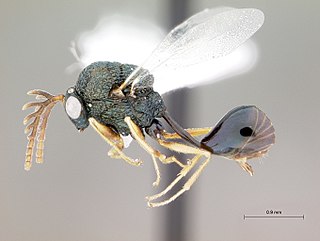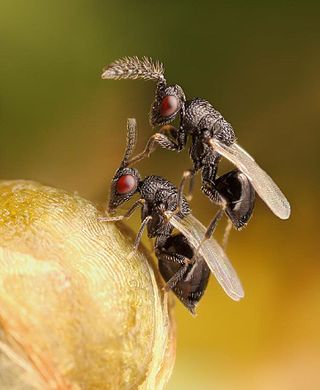
Chalcid wasps are insects within the superfamily Chalcidoidea, part of the order Hymenoptera. The superfamily contains some 22,500 known species, and an estimated total diversity of more than 500,000 species, meaning the vast majority have yet to be discovered and described. The name "chalcid" is often confused with the name "chalcidid", though the latter refers strictly to one constituent family, the Chalcididae, rather than the superfamily as a whole; accordingly, most recent publications (e.g.,) use the name "chalcidoid" when referring to members of the superfamily.

The Eucharitidae are a family of parasitic wasps. Eucharitid wasps are members of the superfamily Chalcidoidea and consist of three subfamilies: Oraseminae, Eucharitinae, and Gollumiellinae. Most of the 55 genera and 417 species of Eucharitidae are members of the subfamilies Oraseminae and Eucharitinae, and are found in tropical regions of the world.

The Eurytomidae are a family within the superfamily Chalcidoidea.

In biology, Lipotriches is a large genus of sweat bees in the family Halictidae, distributed widely throughout the Eastern Hemisphere though absent from Europe. There are nearly 200 species in 9 subgenera. They commonly have prominent bands of hair on the margins of the metasomal segments.

Galeopsomyia is a New World genus of hymenopteran insects of the family Eulophidae. The genus is a hyperparasitoid of other gall-inducing wasps of the genera Eurytoma and Torymus.

Epistenia is a genus of wasps in the family Lyciscidae.

Entedoninae is a subfamily of wasps in the family Eulophidae. The subfamily includes over 90 genera.

Eulophinae is a subfamily of wasps in the family Eulophidae which includes over 90 genera.

Leucospis is a genus of wasps belonging to the family Leucospidae. Most species are brightly coloured with yellow and black patterning and about 2 cm long. They have characteristically enlarged femurs on the hind leg, with the lower margin toothed. The wings have a longitudinal fold and the long ovipositor is bent over their backs above the abdomen or metasoma. They are parasitic on wasps and solitary bees that construct cells and provision food for their offspring. The Leucospis larvae live and grow as ectoparasites of the host larvae. Usually, only one parasite emerges from a single cell. The genus Micrapion from South Africa is very closely related, and phylogenetic studies suggest merging of the two genera. The genus Leucospis is found across the world in the tropical regions.

Haltichella is a genus of chalcidid wasps in the family Chalcididae. There are at least 20 described species in Haltichella.

Conura is a genus of chalcidid wasps in the family Chalcididae, containing more than 300 species described. They are distributed mostly in the New World, especially in the Neotropical region, where 279 species occur. Conura is divided into three subgenera and 63 species groups, which may not form taxonomic entities but reflect patterns of morphology that are useful for focused studies.
A list of the species of Hymenoptera from New Zealand; which includes ants, bees, parasitoids, sawflies, and social wasps.

Dirhinus is a genus of parasitic wasps in the family Chalcididae. The genus has a worldwide distribution.

Chalcedectidae is a small family of chalcid wasps, previously classified as part of the subfamily Cleonyminae, in the polyphyletic family Pteromalidae. Most species are parasitoids of wood-boring beetles.












